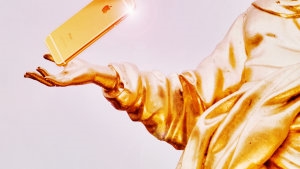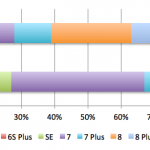The Next iPhone May Not Start At $1,200, But It Will Be Very Expensive
Apple blogger John Gruber set off a wave of chatter last week by suggesting that the upcoming iPhone (which will likely be called the iPhone 8 or the iPhone Pro or something like that) could and should range in price from $1,200 to $1,400.
Gruber argues that Apple has always had to use components in its phones that were mature and could be manufactured in enough quantity to support the device’s massive sales. That meant that newer, cutting-edge features (like wireless charging and bright OLED screens) couldn’t be used in new phones, putting Apple at a real disadvantage versus the competition.
“The best available iPhone should be, at least arguably, the best phone in the world,” Gruber writes. “That might not be possible if all iPhones must be capable of being manufactured in the same quantities as in recent years.”
Gruber states the problem well. It’s his solution I have a problem with. The answer, Gruber says, is for Apple to add a higher-priced premium model to its lineup, a sort of “showcase” phone for all the hottest new components and features. The phone would move fewer units than other iPhones because of its high price, and so could use new cutting-edge components that could be acquired only in lower quantities.
The starting price of the iPhone 8/Pro will be well above the price of today’s most expensive iPhone, the iPhone 7 Plus ($969), but not $231 more. I’d wager we’ll see something more like $1,099 for a 56GB phone going up to $1,269 for the 256GB version.
As Apple prices its new phone, the company will be walking a fine line. If it’s too costly—and if longtime fans aren’t wooed by older models—the company risks losing customers to less expensive smartphones like Samsung.
Apple’s pricing strategy is already evolving, says Above Avalon analyst Neil Cybart. “Apple has been following an iPhone pricing strategy where higher-priced iPhones are introduced at one end based on features and components. Meanwhile, Apple continues to reduce entry-level iPhone pricing to make the product accessible to more people.”
“Stronger than expected demand for the higher-priced iPhone 7 Plus tells us that higher-priced iPhones are very likely,” Cybart adds.
And as my colleague Harry McCracken points out, the fact that the iPhone hasn’t involved very expensive tiers has been an exception to Apple’s general practice, not the rule. You can still pay less than $1,000 for a Mac, but a fully loaded 15-inch MacBook Pro can cost in excess of $3,000.
OLED Crunch
Aside from that strategic shift, Apple may be forced to price its 10th anniversary phone at above $1,000 to maintain its profit margin. That’s because the cost of memory has gone up considerably this year, as I reported in February, and because of the high relative cost of the new OLED screens from Samsung.
OLED manufacturing capacity around the world remains limited. In fact, sources have told me, Apple’s current huge demand for OLED screens is forcing smaller phone makers to put off having their orders filled.
A significantly higher iPhone price point may be a way of dealing with that negative market force, points out Creative Strategies president Tim Bajarin in an email to Fast Company.
“It is not out of the realm of possibility that a new iPhone with an OLED screen could be around $1,000 to $1,200 at first, even though they would be in limited supply,” Bajarin says. “If they did this at this price, the goal would be to help spur more manufacturing of OLED with the intention of bringing OLED to all iPhones over the next two to three years.”
But How Much More?
My problem with Gruber’s argument is the extent to which he proposes jacking up the price of the top-of-the-line iPhone. A dramatic leap in price this year could have some serious unintended consequences.
Firstly, it would introduce a new pricing approach to iPhones. Even as its highest-tier iPhone now pushes $1,000, Apple has priced most of its phones as mass market, one-size-fits-all devices that were within the reach of most types of customers. An exclusive model that only a tiny subsection of Apple users could afford might take some getting used to, and it might send the wrong message.
At the same time Apple announces the new 10th anniversary phone, it’s expected to continue along its normal phone release road map, meaning that the existing iPhone 7 and 7 Plus will move down the line to make way for the iPhone 7S and 7S Plus. But those phones won’t be the ones to get all the hyped-up new features (edge-to-edge OLED, wireless charging, etc.), which will be reserved for that new exclusive phone, the iPhone 8/Pro.
People might say, as Gruber himself puts it, on the one hand, “I don’t want a 7S because it’s boring,” while on the other, “I don’t want to spend $1,200 on an iPhone Pro/Edition because that’s too much for a phone, no matter how nice it is.”
That no man’s land is an unhappy place to put an erstwhile faithful Apple buyer, and it could lead to some defections, probably to Samsung.
In the end, I expect Apple will indeed easily break the $1,000 threshold with the new high-end device. But I think the company will dial down the sticker shock to the point where the iPhone 8 prices look at least somewhat consistent with the pricing of earlier phones.
All the discussion about a $1,200 to $1,400 phone won’t hurt Apple at all. It’ll only get people used to the idea of paying way over $1,000 (for the first time) for the new iPhone. When it’s revealed that the price increase was more modest than expected, Apple will look like a hero, and the iPhone 8/Pro will suddenly look like a good deal.
Apple wants to make this one a masterpiece, and not just one for the masses. But a predicted $ 1,200 starting price could be risky for Apple.
Apple blogger John Gruber set off a wave of chatter last week by suggesting that the upcoming iPhone (which will likely be called the iPhone 8 or the iPhone Pro or something like that) could and should range in price from $ 1,200 to $ 1,400.
Fast Company , Read Full Story
(5)













